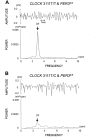Circadian rhythm genes CLOCK and PER3 polymorphisms and morning gastric motility in humans
- PMID: 25775462
- PMCID: PMC4388463
- DOI: 10.1371/journal.pone.0120009
Circadian rhythm genes CLOCK and PER3 polymorphisms and morning gastric motility in humans
Abstract
Background: Clock genes regulate circadian rhythm and are involved in various physiological processes, including digestion. We therefore investigated the association between the CLOCK 3111T/C single nucleotide polymorphism and the Period3 (PER3) variable-number tandem-repeat polymorphism (either 4 or 5 repeats 54 nt in length) with morning gastric motility.
Methods: Lifestyle questionnaires and anthropometric measurements were performed with 173 female volunteers (mean age, 19.4 years). Gastric motility, evaluated by electrogastrography (EGG), blood pressure, and heart rate levels were measured at 8:30 a.m. after an overnight fast. For gastric motility, the spectral powers (% normal power) and dominant frequency (DF, peak of the power spectrum) of the EGG were evaluated. The CLOCK and PER3 polymorphisms were determined by polymerase chain reaction (PCR) restriction fragment length polymorphism analysis.
Results: Subjects with the CLOCK C allele (T/C or C/C genotypes: n = 59) showed a significantly lower DF (mean, 2.56 cpm) than those with the T/T genotype (n = 114, 2.81 cpm, P < 0.05). Subjects with the longer PER3 allele (PER34/5 or PER35/5 genotypes: n = 65) also showed a significantly lower DF (2.55 cpm) than those with the shorter PER34/4 genotype (n = 108, 2.83 cpm, P < 0.05). Furthermore, subjects with both the T/C or C/C and PER34/5 or PER35/5 genotypes showed a significantly lower DF (2.43 cpm, P < 0.05) than subjects with other combinations of the alleles (T/T and PER34/4 genotype, T/C or C/C and PER34/4 genotypes, and T/T and PER34/5 or PER35/5 genotypes).
Conclusions: These results suggest that minor polymorphisms of the circadian rhythm genes CLOCK and PER3 may be associated with poor morning gastric motility, and may have a combinatorial effect. The present findings may offer a new viewpoint on the role of circadian rhythm genes on the peripheral circadian systems, including the time-keeping function of the gut.
Conflict of interest statement
Figures



Similar articles
-
The CLOCK 3111T/C SNP is associated with morning gastric motility in healthy young women.Physiol Behav. 2012 Aug 20;107(1):87-91. doi: 10.1016/j.physbeh.2012.06.006. Epub 2012 Jun 15. Physiol Behav. 2012. PMID: 22709985
-
The CLOCK 3111T/C single nucleotide polymorphism and daytime fluctuations of gastric motility in healthy young women: A preliminary study.Chronobiol Int. 2017;34(10):1478-1482. doi: 10.1080/07420528.2017.1373660. Epub 2017 Oct 24. Chronobiol Int. 2017. PMID: 29064730
-
Association between the CLOCK gene 3111 T > C polymorphism and an irregular menstrual cycle in Korean adolescents.J Psychosom Obstet Gynaecol. 2015;36(4):148-54. doi: 10.3109/0167482X.2015.1089229. Epub 2015 Oct 9. J Psychosom Obstet Gynaecol. 2015. PMID: 26453284
-
PERIOD3, circadian phenotypes, and sleep homeostasis.Sleep Med Rev. 2010 Jun;14(3):151-60. doi: 10.1016/j.smrv.2009.07.002. Epub 2009 Aug 29. Sleep Med Rev. 2010. PMID: 19716732 Review.
-
Phenotyping of PER3 variants reveals widespread effects on circadian preference, sleep regulation, and health.Sleep Med Rev. 2018 Aug;40:109-126. doi: 10.1016/j.smrv.2017.10.008. Epub 2017 Nov 6. Sleep Med Rev. 2018. PMID: 29248294 Review.
Cited by
-
A PER3 Polymorphism Interacts with Sleep Duration to Influence Transient Mood States in Women.J Circadian Rhythms. 2016 Mar 10;14:3. doi: 10.5334/jcr.135. J Circadian Rhythms. 2016. PMID: 27103936 Free PMC article.
-
It's About Time: The Circadian Network as Time-Keeper for Cognitive Functioning, Locomotor Activity and Mental Health.Front Physiol. 2022 Apr 25;13:873237. doi: 10.3389/fphys.2022.873237. eCollection 2022. Front Physiol. 2022. PMID: 35547585 Free PMC article. Review.
-
Circadian Rhythms and Melatonin Metabolism in Patients With Disorders of Gut-Brain Interactions.Front Neurosci. 2022 Mar 9;16:825246. doi: 10.3389/fnins.2022.825246. eCollection 2022. Front Neurosci. 2022. PMID: 35356051 Free PMC article. Review.
-
Evolving roles of circadian rhythms in liver homeostasis and pathology.Oncotarget. 2016 Feb 23;7(8):8625-39. doi: 10.18632/oncotarget.7065. Oncotarget. 2016. PMID: 26843619 Free PMC article. Review.
-
Circadian Rhythms and the Gastrointestinal Tract: Relationship to Metabolism and Gut Hormones.Endocrinology. 2020 Dec 1;161(12):bqaa167. doi: 10.1210/endocr/bqaa167. Endocrinology. 2020. PMID: 32954405 Free PMC article. Review.
References
-
- King DP, Takahashi JS. Molecular genetics of circadian rhythms in mammals. Annu Rev Neurosci. 2000;23: 713–742. - PubMed
-
- Zylka MJ, Shearman LP, Weaver DR, Reppert SM. Three period homologs in mammals: differential light responses in the suprachiasmatic circadian clock and oscillating transcripts outside of brain. Neuron. 1998;20(6): 1103–1110. - PubMed
Publication types
MeSH terms
Substances
LinkOut - more resources
Full Text Sources
Other Literature Sources
Research Materials
Miscellaneous

